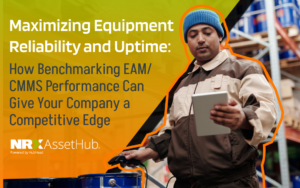When it comes to asset management, it’s like taking care of a car. You wouldn’t wait for your car to break down before performing maintenance. Instead, you would regularly inspect and maintain it to keep it in good condition. In the same way, assets in asset-intensive industries require regular maintenance to ensure their reliability and performance.
Reliability-centred Maintenance (RCM) is a systematic approach to maintenance that can help businesses improve asset performance and reduce downtime. In this blog post, we will explore best practices for implementing RCM and the role of benchmarking in adopting these practices.

Best Practices for Improving Asset Performance with RCM
1. Identify Critical Assets: The first step in implementing RCM is identifying critical assets that are essential to the business. By identifying these assets, you can prioritize maintenance activities and ensure that they are maintained to the highest standards.
2. Determine Failure Modes: Once you have identified critical assets, the next step is to determine their failure modes. This involves identifying how assets can fail and the consequences of failure.
3. Develop Maintenance Strategies: Based on the failure modes identified, develop maintenance strategies that will prevent or mitigate failure. These strategies may include preventive maintenance, predictive maintenance, or condition-based maintenance.
4. Implement Maintenance Tasks: Once maintenance strategies have been developed, implement maintenance tasks based on the criticality of the assets and the identified failure modes.
5. Monitor Performance: Regularly monitor the performance of assets to ensure that maintenance tasks are effective and assets are performing optimally.
The Role of Benchmarking in Adopting RCM Practices
Benchmarking is the process of comparing asset performance to industry standards or best practices. Benchmarking EAM/CMMS usage is critical in adopting RCM practices as it allows businesses to evaluate their current maintenance practices and identify areas where they can improve. Benchmarking can help businesses in the following ways:
1. Identify Gaps: Benchmarking can help businesses identify gaps in their current maintenance practices, including missing or incomplete data.
2. Evaluate EAM/CMMS Usage: Benchmarking can help businesses evaluate their EAM/CMMS usage and identify areas where they can improve data quality and accessibility.
3. Determine Specific Best Practices to Adopt: Benchmarking allows businesses to identify a personalized list of best practices they must adopt according to what others use in their industry.
4. Create an ROI-Based Roadmap: Benchmarking can help businesses create an ROI-based roadmap to bridge gaps and improve their maintenance practices.
Need Help Adopting Reliability-Centered Maintenance Practices?
If you want to adopt RCM practices and improve asset performance, consider contacting us to learn more about HubHead’s benchmarking service. Our experienced consultants evaluate EAM/CMMS usage based on best practices in the industry and can create an ROI-based roadmap to bridge gaps and improve your maintenance practices.
Follow the links below to download our benchmarking service brochure or book a meeting to get in touch with one of our consultants; we would be glad to assist you in your benchmarking journey.

Maximizing Equipment Reliability and Uptime: How Benchmarking EAM/CMMS Performance Can Give Your Company a Competitive Edge
Working Smarter, Not Harder: Strategies for Improving EAM/CMMS Performance Based on Benchmarking Results
Revamping Maintenance Processes: How Benchmarking Boosts Efficiency
Share this article




